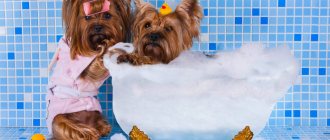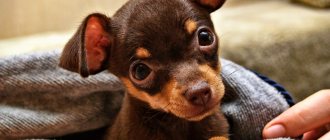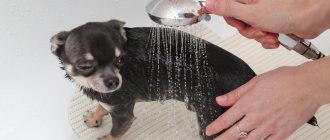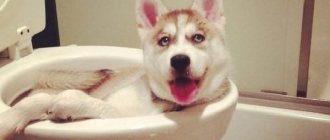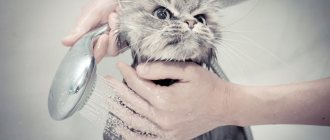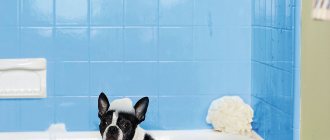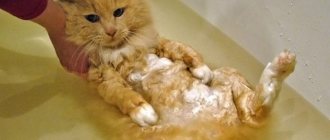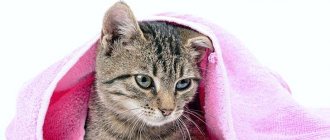When can you bathe a puppy for the first time?
In the first days of life, newborn puppies are washed by their mother, thoroughly licking her offspring.
Experts advise starting to introduce young animals to water and shampoo 2-4 weeks after vaccinations, which must be done at two months of age. In order for the baby to get used to the water and in the future to delight in encounters with the bath, the first bath in his life should be accompanied only by positive emotions. • Put everything aside. Neither your children's homework nor cooking dinner should distract you from bathing your pet. Prepare the necessary supplies in advance: towels, shampoo and wool brushes.
• If you are using a bathtub for the procedure, place an anti-slip mat on the bottom of the bathtub. Fill the container with water 5-10 cm (depending on the size of the dog). The baby should not feel like he is drowning.
• Introduce your little friend to bathing gradually. Let him hear the sound of water and get used to it. Then you can play with the dog by spraying water on its fur. Once your puppy's worries have subsided, gently place him in the liquid. Make washing fun by bringing your favorite toys with you. Constantly praise your pet, talk to it, and give it treats.
By following these simple rules, you will help your baby overcome his fear of bathing and subsequently perceive encounters with water and shampoo as a pleasant game.
Sometimes breeders sell puppies from the age of 1.5 months. It is at this time that babies receive the first vaccination in their lives. But more often than not, breeders sell purebred puppies to pet lovers from the age of 3 months. It is at this time that new owners usually bathe the acquired dog.
Some pet lovers are interested in whether it is possible to bathe a puppy once a month. Most veterinarians do not advise doing this. The same breeders usually do not bathe their puppies before selling them at all. Most often, the dog takes a real bath for the first time in the owner’s house. The fact is that until the age of three months, babies’ immunity is not yet very well developed. Consequently, when bathing a very small dog can simply catch a cold.
It is also not recommended to bathe older puppies too often. The fact is that until the age of about 6 months, dogs’ fur still has virtually no guard hair. However, it is much less common than in adult dogs. The danger of private bathing for small puppies lies in the fact that the protective fatty film on their skin is still thin and is easily washed off.
Bathing Tips
To wash your puppy without harming him, you need to follow a number of recommendations.
Which container is better?
You can wash your small pet in a bathtub or basin. The choice of one option or another depends on the size of the animal and personal preferences.
The water level should not be excessively high. It is enough for it to reach the knee joints or cover the paws.
Water temperature
The water should not be excessively hot or cold. The optimal temperature is considered to be within +35 °C. In this case, the puppy will feel comfortable and will not catch a cold.
Precautions: rubber mat on the bottom
In order for your pet to calmly endure the procedure and not be afraid, you need to lay a rubber mat on the bottom of the container. Thanks to this, it will be possible to prevent unwanted sliding, the animal will stand firmly on its paws.
Washing with an assistant
It is advisable to perform the procedure with an assistant. This is due to the fact that the puppy can break free and try to jump out of the basin or bathtub.
It is much easier to wash it with two people: while one person holds the dog, the other calmly wets, lathers and rinses the fur.
The importance of a positive attitude
While washing, you need to speak kindly to the animal and be as careful as possible. You should not make sudden movements.
It is extremely important that the atmosphere is calm. This is necessary so that the baby gets used to bathing and trusts his owner.
Procedure
You need to bathe a mongrel and a purebred puppy using the same technology. In this case, you should perform the following actions:
- Taking your pet under its belly, immerse it in water.
- Wait a little time for the animal to get used to the unusual sensations and get used to it.
- Pour a small amount of shampoo into your hand and apply it to the fur.
- While stroking, soap the dog.
- Rinse the animal. To do this, you need to fill a ladle with warm water and slowly water the animal. Shower use is also permitted.
- When all the shampoo has been washed off, remove the puppy from the water container and wrap it in a towel.
Why you shouldn’t wet your nose, ears and eyes
It is extremely important that water does not get into the puppy’s ears, otherwise the risk of developing ENT diseases increases. To avoid this, it is recommended to place cotton swabs in your ears.
It is also worth making sure that soapy water does not get into the eyes and nose: the delicate mucous membranes become irritated, and the dog begins to experience severe discomfort.
Because of this, your pet may experience panic. Water that gets into the nasal passages can cause the puppy to choke.
How to dry wool
To dry the animal, it is strictly forbidden to use a hair dryer. Hot air can burn delicate skin. The puppy just needs to be taken to a warm room and dried with a towel.
The main thing is not to overdo it so that the animal does not experience pain.
Basic rules - bathe your pet yourself
When you can bathe a puppy for the first time is therefore clear. But how often should this procedure be performed in the future? Unfortunately, there is no clear answer to this question. The frequency of water procedures for a puppy depends on many factors.
If a dog, for example, was purchased to guard a private home and is kept outside in a kennel, then, of course, you may never have to bathe it at all. If the dog was bought to live in an apartment, he will most likely have to take water treatments quite often.
The frequency of bathing a puppy depends primarily on how quickly its fur becomes dirty. In autumn and spring, in damp weather, you will most likely have to wash your dog more often. In summer and winter, dogs' fur becomes dirty more slowly. Accordingly, the animal will have to take water treatments less often.
Usually, owners of puppies when keeping them in an apartment bathe them once every 1-1.5 months. In any case, it is not recommended to wash your pet too often before 6 months.
The answer to the question of how often you can bathe a puppy, therefore, depends on the degree of cleanliness of the latter, the time of year, etc. But of course, owners of such pets should know not only about when to introduce them to bathroom and how often to wash it in the future. The dog owner also needs to have an idea of how to properly bathe puppies.
Experienced breeders recommend washing such pets after evening walks. When performing this procedure, it is recommended to follow the following rules:
- All your household chores should be put aside for a while. Leaving a small puppy in the bathroom alone is not a good idea.
- A rubber mat should be placed on the bottom of the bathtub. Otherwise, your pet's paws will slip.
About half an hour before bathing, the puppy must be fed. The dog should not experience any anxiety while taking water procedures.
Most puppies, unlike kittens, love to wash themselves. But very small dogs, not yet accustomed to bathing, may experience a little stress in the bathroom. If the puppy is afraid, the owner should try to calm him down. While bathing your pet, you need to stroke it and speak to it in a calm, encouraging tone.
The puppies begin to be washed with shampoo from the back. Then they move onto their sides and then onto their paws. The head and tail are washed last. To prevent water from getting into your pet's ears, you can insert special plugs into them, which can be purchased at a pet store.
Water for bathing puppies should be used exclusively warm - approximately 38 ° C. After taking water treatments, your pet should be wrapped in a thick terry towel, blotted and then kept wrapped for 20 minutes. Babies with long, beautiful hair are sometimes also blow-dried after a bath.
It is recommended to wash the puppy in the evening, after feeding and walking.
1. To avoid drafts, close the room door. Pour some warm water (about 36°C) into the bathtub. For bathing small breed babies, it is better to use a separate container - a basin or trough.
2. Comb your pet's fur thoroughly. Insert cotton swabs into the baby's ears. Place the dog in a container of water.
3. Gently and evenly wet the animal. Dilute the shampoo with water in a ratio of 1:4, whisk it and, starting from the withers, apply foam to the dog with massaging movements. Lastly, wash the neck and face. Do not pour water on your head, as this may cause liquid to get into your nose and ears.
4. Do not use detergents intended for human use. The ingredients found in “human” shampoos negatively affect the functioning of the dog’s sebaceous glands and cause allergic reactions, dandruff and itching. Perfume fragrance is also unlikely to be to the taste of your four-legged friend.
5. As a finishing touch, you can apply a softening balm to the wool. Then rinse the animal generously with running water several times. Dry your pet with a soft towel and remove the swabs from the ears. If you use a hair dryer, dry the coat in the direction it grows and avoid hot air. At the end of the procedures, comb the puppy thoroughly. After 3-4 days, treat it with parasite repellents.
Have you often noticed mongrels occupying bodies of water? It’s true, you won’t see a sight like this. In their natural environment, dogs never “take a bath.” At the same time, outright dirty people are also rarely encountered. The coat of smooth- and wire-haired dogs is adapted for self-cleaning.
Another thing is purebred pets, which are distinguished by fur that is far from natural. Long-haired dogs, especially those whose hair is most similar to human hair, need water treatments relatively often. Regular wiping of paws after a walk is not necessary in this case.
In the context of washing, dogs are divided, among other things, into adults and puppies. We will discuss the frequency of bathing in the next section. But even basic logic suggests that puppies need washing much less than mature animals. About puppies and adult pets - video at the end of the article.
You won’t find a recommendation in any canine reference book: “Be sure to bathe your dog once every...”. Traditionally, pets are washed once every six months or quarter, “careerists” are bathed before exhibitions, and especially fastidious cleanliness once every 7–10 days. Owners of large dogs should consider the services of grooming salons or a “support group.”
- An hour before swimming, windows, doors and other sources of air flow in an apartment or house should be tightly closed. A wet dog and a draft do not mix!
- Be sure to bathe your dog while wearing a collar and leash.
- Under no circumstances should water or shampoo get into your ears! Pets with cropped ears bathe in a “hood” or do not wash their hair - a simple but very important rule!
- In addition to tying up the dog, the floor of the bathtub must be completely covered with a sheet or blanket. If the pet breaks out, he may not be able to stay on his wet paws and develop fractures.
- We make sure to put a muzzle on the dog if it bites or has “sinned” in such actions before. It is advisable to use a nylon muzzle; this will protect the owner from bruises and the bathroom from destruction.
- Prepare an appropriate wardrobe. The dog will cowardly, pouring water all around - this is normal. In a fit of emotion, the dog can begin to climb on your hands, actively working with its claws - long sleeves are required.
- Praise and encourage the dog during bathing, do not use brute force, reward your pet generously after the procedure.
- You'll need a lot of towels! Based on the size of the dog, prepare 5-10 towels; your task is to wipe the dog until it is as dry as possible.
- Using a hairdryer is acceptable, but! Drying should be carried out at low power, with cold or slightly warm air. Don't scratch the fur while blow-drying! Drying your pet “like yourself” will cause serious harm to your dog’s skin.
- Walking is contraindicated for the dog for several hours after bathing. If your pet runs around the house, don’t forbid it; this is a natural way to maintain muscle tone and body temperature after getting wet.
We suggest you familiarize yourself with: Original nicknames for cats, choosing a name for a male
In the autumn-spring period, the pet returns home with dirty paws, and sometimes, a belly. A few rules for washing your dog after a walk:
- It doesn’t matter what time of year you got a puppy, if you plan to wash your paws, accustom your pet to this procedure from childhood.
- In autumn it is allowed to wash with water at room temperature, in winter - only with cold water! Want to know why? Try placing frozen feet in a bowl of hot water, feel the burning, tingling, pain and general discomfort, multiply this by 2 - this is exactly how your pet feels.
- Do not use deep containers, this will reduce the moral aspect of washing. A small rectangular basin from which the dog can freely reach his paw is suitable.
When purchasing a puppy, think about the moment of bathing in advance and prepare your pet gradually. Many dogs calmly bathe when they are watered with a hose, and furry pets, if provided with conditions in the hot season, take a bath on their own. The key to intact paws, furnishing the house and the absence of abrasions on the owner is upbringing from childhood.
None of the dog handlers will ever say how many times a year you need to bathe your pet. Basically, dogs are bathed once every six months or once every three months. Particularly fastidious dog owners bathe their dog once every 5-7 days. If you have a large dog, it is recommended to seek help from specialized salons.
When washing your pet in an apartment, you need to consider several recommendations:
- About 1-2 hours before swimming, it is necessary to close all doors, windows and vents - a wet dog and a draft are not compatible things;
- The pet must take a bath only wearing a collar and leash;
- Do not allow shampoo, soap or water to get into your pet's ears. Animals with cropped ears wash with a cap or do not wash their hair at all - the rule is the simplest, and following it will not allow your pet to get sick;
- You should be concerned about your pet's health and cover the bathroom floor with a large blanket or sheet. These measures are necessary to ensure that, after jumping out of the bathtub, the dog does not slip on wet paws and simply break its bones;
- If your dog has bitten before or still continues to do so, it is recommended to wear a muzzle - this will avoid unnecessary injuries to the owner and a bath from unnecessary pogroms;
- While washing your pet, do not force it to sit there - praise the animal and encourage it. If necessary, treat them to a “yummy” treat;
- For drying you will need several towels - their number is calculated based on the size of the dog. Remember! After washing, the pet should be as dry as possible;
- You can't blow dry your dog! If you use it, then the blowing should be done with a slightly warm air stream;
- After bathing, you should not drag your dog outside. If she starts running around the house, don’t interfere. This is a natural process of muscle recovery and toning.
- To simplify all this, you can cut your dog’s hair (preferably with a clipper).
Rules for bathing a pet
The puppy can be washed in the bathroom or under the kitchen faucet. To minimize discomfort, you should bathe your Yorkie in compliance with the following rules:
- Before bathing, the puppy's skin is examined for damage. If there are injuries, washing is postponed until complete healing.
- Premium cosmetics are highly concentrated. Before use, it must be diluted with water according to the instructions.
- Bath procedures should not cause fear. In the process, they avoid sudden movements that can frighten the Yorkie puppy, talk to him affectionately and praise him.
- To prevent water from getting into the ears, they are covered in advance with cotton swabs or sprinkled with special powder.
- You need to bathe your Yorkshire Terrier as quickly as possible to prevent it from freezing. For professional breeders and groomers, this takes 7-10 minutes.
Choosing dog washing products
Both puppies and adult Yorkies are bathed only with special cosmetics. Care products are not suitable for people - they have a more aggressive composition, so they dry the skin and cause allergies.
Important. The Yorkshire Terrier should not be bathed with cheap cosmetics - it will do more harm than good.
Water ranks first in dog shampoo, followed by sodium laureth sulfate or other surfactants. They perfectly cleanse the skin and coat, but can cause irritation. Therefore, high-quality products contain additives that mitigate the negative effects.
They also contain moisturizing and nourishing components that improve the structure of the fur.
Dog trainers and breeders recommend bathing Yorkies with the following brands of shampoo:
- Royal Groom – designed specifically for Yorkshire Terriers. Restores dry ends, smoothes hair, enhances shine.
- IvSanBernard is a hypoallergenic shampoo, suitable even for Yorkies with sensitive skin. Carefully cares for the coat, restores the protective layer, and is suitable for frequent use.
- Artero Hidratante – contains horse chestnut and chamomile extracts, provitamin B. Moisturizes and restores damaged hair.
- ReQual Nutri Derm - contains propolis, willow leaf extract and yeast extract, which perfectly moisturize, add shine and softness.
- Pet Silk – fights dandruff and inflammation, increases fur elasticity and color saturation.
- ReQualVitalProf - nourishes, conditions, makes fur shiny and silky.
- AllSystems - the line includes nourishing, regenerating, moisturizing, softening and strengthening detergents. The products consist of plant materials without the addition of chemical components.
- Artero – enriched with moisturizing agents and vitamins, adds volume and shine.
Advice from veterinarians
So, we found out when you can bathe a puppy for the first time. Usually this procedure is performed no earlier than 3 months. But what to do if a very small puppy gets very dirty? In this case, experienced veterinarians and breeders advise simply wiping the pet’s fur with a damp cloth or a special mitten.
The smell of urine emanating from them often causes trouble for owners of puppies. Small dogs' legs are still short. And having made a puddle on the floor, puppies usually also dip their butts into it, and often walk over it with their paws.
In this case, it is also not necessary to bathe the puppy. You just need to put the dog in a basin with a small amount of water, wash it and rinse its paws. Experienced breeders recommend wiping the area where the puddle was with vinegar. The smell of this substance lasts for a long time. And the puppy will not leave any more puddles in this place.
Breeders also do not recommend bathing a newly purchased 3-month-old dog right away. A change of environment causes quite a lot of stress in puppies. And bathing at this moment can aggravate the problem. A puppy brought home must first be allowed to get used to its new home.
Some pet lovers are also interested in whether it is possible to bathe a puppy before vaccination or not. Veterinarians and breeders do not advise doing this under any circumstances. Even 6-month-old puppies have a weaker immune system than adult dogs. Therefore, a bathed pet will definitely get sick after vaccination.
Getting to know water
Before the first bath, the puppy is first introduced to the water. The process takes place gradually and slowly. To do this, the pet is brought to a bath filled with water or a swimming pool and gently lowered. At the same time, the baby is gently held by the stomach.
In a calm environment, the puppy quickly gets used to the water and after a short period of time willingly bathes. Some breeds were originally bred to work in reservoirs, so there are practically no problems with them.
However, if your pet still experiences anxiety and restlessness, then it is better not to make him hysterical. It is necessary to carefully remove the puppy from the water and reschedule the introduction to the water for the next time.
It is important! Under no circumstances should you suddenly throw a puppy into a pond or pour water on it. The baby will get stress and hydrophobia for life. Subsequent attempts to bathe the dog will be accompanied by panic on the part of the animal.
How to wash your dog after a walk
Some dogs shit in the apartment due to the retention of their own urine odors on the floor coverings. To prevent floors from smelling like “dog,” it is best to thoroughly wash them with products that smell like bleach. This is whiteness, Domestos and other means. They should be diluted with water, and the floors should be thoroughly rinsed after using such products. Vinegar and potassium permanganate solution also help get rid of the smell.
Maintaining cleanliness and getting rid of unpleasant odors in the house where your four-legged friend lives is difficult, but quite possible. Teach your dog to behave civilly - not to climb on the sofa, to wash his paws after walks.
If you have a puppy, his training should include teaching him to bathe - while he is small, this is quite easy to do.
Now, let's look at a few basic rules for bathing a dog in the spring and autumn, when he comes running from the street with a dirty belly and paws:
- Regardless of the time of year when you brought your baby home, you must immediately teach him to wash his paws after a walk;
- In spring and autumn, paws are washed exclusively with slightly warm water. In winter it is extremely cold. The problem is that the sensitivity of a dog's paws is twice as high as ours - so imagine what will happen to your pet if you put his paws in a basin of hot water;
- Do not use a large capacity container. It is enough to take a small basin and a cloth;
- When you get a puppy, you should immediately think through the process of getting used to washing after going outside.
In the summer or hot weather, many dog breeders simply water their pets with a hose, and they are calm about it. If your dog has thick hair, then in hot weather, by giving them a bath, they will jump into it themselves and cool off.
If the baby is bathed as rarely as possible, then washing his paws after street walks should become a mandatory procedure. And it's not just about hygiene. Chemicals spilled on the ground remain on the pads (reagents used to treat streets in winter are especially dangerous). In addition, even hard sole fabrics can be damaged by glass shards, thorns and splinters.
Teach your friend to wait patiently in the hallway until you complete the necessary manipulations. Prepare your equipment: a basin, shampoo, rags (microfiber is best) and a dry towel.
Attention! During the cold season, use only cool water - temperature changes can negatively affect the condition of the skin. In winter, first wet the belly and paws, apply detergent, rinse with water and pat dry with a towel. In summer, in dry weather, it is enough to wipe the paws with a damp cloth.
We suggest you read: Which cereals can be given to dogs, and which ones should be avoided
After each walk, carefully inspect the paw pads. If you find even the slightest scratch, treat it with a disinfectant.
Fleas on foundlings
Sometimes people take home very young puppies thrown out onto the street. Such dogs can, of course, be infested with fleas. The answer to the question of when you can bathe a puppy for the first time is, as we found out, at the age of 3 months. If a very small foundling is infected with fleas, it is therefore not worth washing it with antiparasitic shampoos.
In this case, you must first remove all debris from the puppy’s fur and wipe it thoroughly with a damp cloth. Next, you should wait until the dog’s fur dries and use flea spray or drops, according to the manufacturer’s instructions. To remove parasites, of course, in this case you need a product designed specifically for small puppies.
Choosing wash products, skin type matters
The question may arise - how to wash a dog if there is no shampoo? Everything is simple here - you can use baby shampoo with a sufficient content of lecithin and lanolin. If you don’t even have baby shampoo on hand, rinse your pet’s skin with plain warm water.
“Scented” dogs that have rolled around in dirt or garbage should never be washed with soap! It is better to break the egg yolks into the water and mix them thoroughly. Use the resulting mixture as a rinse, thoroughly massaging the skin and then rinsing it off with a stream of water.
Attention! If your dog's coat becomes dull, this is the first sign that the detergent you are using is not suitable for your pet.
How to wash a dog so that it doesn’t smell like a dog is another pressing question that arises for many dog breeders. You should immediately take into account that healthy pets will not smell, since this is unnatural in nature for a predator. The appearance of an aroma is a signal of poor (incorrect) care for the dog.
Tip: Do not spray your dog with perfume or deodorant! These manipulations can not only ruin the animal’s fur and harm the skin, but can also easily deprive the pet of its sense of smell!
To get rid of dog smell, it is recommended to perform the following manipulations:
- Regularly wash the rug on which your puppy sleeps (at least once every two weeks);
- Constantly wipe the place where the dog rests;
- Stress – out of fear, a puppy can secrete a special secretion that will only increase the level of unpleasant aroma;
- Constantly monitor the condition of your dog’s ears – just enough of them for the aroma to spread throughout the entire room;
- Monitor the condition of the coat. Constantly comb out excess fur;
- A pet diet can solve the problem. Eliminate all junk food from his diet. If the amber disappears during proper nutrition, it means your pet is allergic to some product;
- To eliminate a weak unpleasant odor, special dog perfumes are sold;
- You can also get rid of ambergris by wiping the dog’s fur with a solution of water and vinegar. Remember, the procedure should not be repeated more than once a month.
Pay attention to such a factor as the use of dog deodorants - by masking the aroma, you can miss the manifestation of symptoms of possible diseases. If nothing helps and the unpleasant dog smell remains? Are symptoms of the disease starting to appear? Let's take our pet with us and hurry to the veterinary clinic!
Remember the old ad about “pH 5.5”? Not everyone knows what this indicator actually means. PH is the level of active hydrogen ions in a solution or liquid, which is indicated by its acidity. The normal pH of a dog's skin is 7.4 - drier, more sensitive, susceptible to the harmful effects of cleansers. Few manufacturers indicate the pH level on the packaging, this is not surprising - research technology is expensive, and production is even more expensive.
It is almost impossible to get rid of foreign odors without using detergents. What to do if you don’t have a special shampoo, and your pet has “perfumed” in the nearest pile of garbage? Can I wash my dog with baby shampoo? – In a catastrophic event, it is possible. It is advisable that the shampoo be intended for infants and contain lecithin or lanolin.
Show dogs take baths more often; special products should be used to preserve the quality of their coat and color. White wool turns yellow from washing, a product with reflective particles will help. Brown or chocolate shades can be “refreshed” with tinting conditioner, but the dyes must only be natural!
Dogs should not be washed with human shampoo. “Human” detergents are completely unsuitable for four-legged friends due to incompatibility with the sebaceous layer of dogs. Regular shampoos disrupt the functioning of the glands, as does frequent bathing. They also have a negative effect on the wool itself. It turns out that there is a double negative effect on the dog’s coat – directly and due to the malfunction of the sebaceous glands.
Moreover, after licking human shampoo, a pet can easily become poisoned. Regardless of whether it is rinsed off, the detergent often causes itching and allergies. How to wash a dog? Only dog shampoos, of which the market offers a huge amount. But you need to buy based on the type of dog’s coat - watch the video about detergents.
There are two types of shampoos: rinse-off and leave-in. The former are clear, but the latter are a spray or powder. They are convenient to use when there is no possibility of proper washing. We recommend using the shampoo in combination with conditioner. The latter removes the static effect, moisturizes the skin, helps reduce the evaporation of fluid from the skin and restores the protective fat barrier.
How to wash a dog
If you decide to give your pet a bath, it’s certainly for a reason. The reason for this may be pollution, bad odor or various diseases, so simply warm water will not cope with this.
You can learn more about the types of dog bathing products from our article.
Types of shampoos
Various products for dogs will come to your aid, depending on the problem you have:
- cosmetic shampoos and liquid soap - used to remove dirt, suitable for frequent use; also used before exhibitions to give the coat the proper appearance, can be used in combination with wool conditioner (shampoo and soap Pchelodar, Agrobioprom, Shoe, Espree and ISB conditioners for various breeds and types of wool);
- hypoallergenic shampoos - for pets with a severe allergic reaction to conventional cosmetics (Perfect Coat, Mr. Bruno, Gentle shampoos);
- medicated shampoos - against fleas and ticks, against fungus and antibacterial - are best used as prescribed by a doctor and strictly follow the instructions for use from the manufacturer (Api-San, Doctor, Elite, Chlorexiderm, etc.).
If it is necessary to treat your pet with a medicated shampoo, first wash it with a cosmetic product to remove dirt.
Tar soap
Tar soap
To get rid of fleas, tar soap is also often used to bathe dogs. However, remember that this remedy does not kill skin parasites, but repels them. When treating with tar soap, it is necessary to keep it on the fur for at least 5 minutes, then comb out the parasites intoxicated by the smell. The procedure will need to be repeated several times every three days. By the way, the specific smell of tar will remain on the dog’s fur for quite a long time after bathing.
How to choose a cosmetic shampoo
To keep your pet looking good and healthy, you need to not just bathe him, but bathe him with the right product. To do this, you need to consider several aspects:
- for the best effect, the shampoo should be selected in accordance with the type and length of your pet’s coat;
- if you often bathe your dog, then the shampoo you choose should be suitable for frequent use;
- it is necessary to monitor the animal’s reaction to shampoo and, in case of allergies, choose a hypoallergenic shampoo;
- for the safety and effectiveness of the shampoo, you should choose products from well-known manufacturers;
- Never use detergents intended for human use, including laundry soap. “Human shampoo” can cause negative consequences - itching, hair loss, and an allergic reaction.
If you use shampoos and other products to bathe and care for your pet’s coat, they must be of high quality, well-chosen and safe for the animal.
My dog smells like “dog”, what should I do?
This breed is very popular in Russia today. Labradors were bred as hunting dogs. Often they had to bring the prey to the owner, including by swimming. These dogs have a strong immune system and rarely get colds. Therefore, a three-month-old puppy of this breed can be washed completely without fear.
Some experienced breeders, when answering the question of how old Labrador puppies can be bathed, even give an age of 2 months. The breed is really strong and accustomed to water. So even a small Labrador will most likely not catch a cold after a bath.
These puppies are absolutely not afraid of water. So the owners will most likely not have any problems with bathing them. Experienced pet lovers recommend giving your Labrador puppy complete freedom of action in the bath. Such a dog will definitely want to frolic in the water and the owner should allow him to do so.
Labradors are usually washed without using shampoo. The coat of such dogs is very thin and can begin to break when chemicals are used. Breeders recommend using shampoo when bathing Labradors no more than 3 times a year and only if the dog is very dirty.
The so-called dog smell causes discomfort not only to owners, but also to pets. A healthy dog does not smell, this is the key to survival in the wild. The appearance of an odor indicates a violation of maintenance standards or the presence of a disease.
If the problems are cosmetic in nature, the root causes need to be determined. To avoid smelling like a dog you need to:
- Clean and wash your dog's bedding at least once every 14 days. Wet cleaning of the place and apartment at least once every 7 days. Pay attention to the dog's reaction to the vacuum cleaner; if the pet is clearly frightened, this may cause the release of a special secretion, which only enhances the smell.
- Check to see if the smell gets stronger when your dog is scared or nervous - stress can cause skin odor.
- Monitor the condition of your dog's ears, especially for fold-eared breeds. One ear can exude a scent that is enough to fill an entire apartment.
- Brush your dog thoroughly. The loose, but not combed out undercoat creates a “steam room” for the dog’s skin. The natural reaction of the skin is protection, secretion of additional sebum and secretions.
- Eliminate any junk food from your diet. If it helps, the dog is most likely allergic and its further management should be adjusted after consultation with a doctor.
- If the smell is present, but does not cause much discomfort, you can use dog deodorants.
- The smell can be removed physically - wipe the dog's fur (!) with a weak solution of vinegar and water. The procedure cannot be repeated more often than once a month!
We suggest you read: How to train a puppy to use the toilet outside, instructions and recommendations
Cosmetic treatments don't help? Has a stress reaction been ruled out? Is the smell getting worse or is your dog showing signs of illness? – without putting off going to the clinic! It is impossible to identify the physiological causes of foreign odors without an examination; a simple examination will not help either. Minimum program: blood tests, examination for kidney and liver failure, checking for the presence of worms and diseases of the gastrointestinal tract.
How often to wash your puppy
When washing a dog with special products, the natural protective fat film of the coat is destroyed. Recovery takes at least six weeks. Frequent bathing with detergents leads to the appearance of parasites and diseases of the coat and skin: baldness, seborrhea, eczema, dermatitis.
When asked how often to wash a puppy, experts answer: “As needed, but as rarely as possible.” The frequency of water procedures depends on several factors: where the pet is kept, participation in exhibitions, coat length and the presence of allergies among the owners. On average, veterinarians recommend washing a young animal no more than 3-5 times a year.
Attention! If your pet has become infected with a fungus or parasites, you must bathe it several times in a row, treating it with special preparations after the procedures. Only a veterinarian can prescribe medications and treatment regimens.
There can be a long debate about how often to wash dogs. Previously, there was an opinion that wire-haired and smooth-haired animals needed to be washed a couple of times a year. Now the situation is different and there is no consensus. Let's consider three versions.
- Dogs can only be washed 2-3 times a year. An exception to the schedule is when the pet has rolled around in the mud or something frankly worse. The arguments are simple - dogs have a sebaceous layer that nourishes both the skin and fur. Frequent bathing, especially with the use of detergents, leads to disruption of the fat layer. As a result, the hair coat, which the dog breeder strives to clean, becomes worse.
- You can and should wash your pets once a season or a little more often. The arguments are the same, only the opinion regarding the reaction of the sebaceous glands to the frequency of bathing is slightly different.
- You can bathe animals once every couple of weeks. Adherents of the theory claim that less frequent bathing leads to cell death and difficulty in removing them. More frequent washing, again, leads to the problem described above.
While the first two theories can still be debated, the last one looks very strange. Just look in the direction of stray dogs. The truth, as usual, is in the middle, so we recommend washing your dog after the end of the quarterly period. Twice a year is too rare, but 3-5 is optimal, not rare and not often.
A separate issue is bathing a puppy and a pregnant dog. It is generally not advisable to wash puppies until they are two months old. Only after a walk should you wipe your paws. “Young children” have a weaker body, which makes it much easier to catch infections and colds. The same applies to pregnant and elderly pets. There is no need to strain them with excessive “garbage”.
The recommended schedule does not mean that it cannot be violated. How can you not violate this when the animal is up to its ears in mud? In bad weather, after a walk, wiping the paws is often accompanied by the need for a full bath. Especially if the pet is small and long-haired. You can also ignore the schedule before shows and after the end of estrus to reduce the smell.
You can also deviate from the schedule if you use flea-tick remedies in the form of drops. You should not bathe your dog with detergents for two days before and after treatment.
Don't neglect water treatments
Bathing is an important procedure for a puppy. The owner must be aware that cleanliness of the coat and skin protects the pet from diseases and parasites. Some of the most common insects found in puppies include ticks and fleas.
There are many benefits of water procedures. The most significant ones include:
- cleanliness of fur and absence of fleas;
- neat appearance of the puppy;
- no unpleasant odor;
- reducing the risk of lichen and other skin diseases.
However, frequent water treatments can harm your pet by washing away the protective fatty lubricant. Therefore, you should not wash the puppy after every walk; it is better to carry out this procedure as needed.
The benefits of water procedures
In some cases, if the bathing procedure is performed incorrectly, liquid and detergents get into the puppies' ears and eyes. This can lead to hearing and vision problems. Therefore, special care must be taken.
Important! Each breed of dog may have individual characteristics that are recommended to be observed during bathing.
German Shepherd
Such dogs are most often used, of course, as guard dogs in the courtyards of country houses. However, in most cases, German Shepherd puppies are never bathed. But if such a dog is kept in an apartment, he will, of course, have to be washed from time to time.
At what age can you bathe a German Shepherd puppy? For the first time, such dogs, like representatives of most other breeds, are usually washed no earlier than 3 months. In the future, you should try to bathe such a baby as rarely as possible, and even more so with the use of shampoos. The protective fatty film on the coat of shepherds and on their skin is very thin.
German Shepherds are usually bathed no more than three times a year. However, in winter this procedure is not performed. A German Shepherd puppy can catch a cold very easily.
How to wash a small poodle
This dog breed belongs to the hypoallergenic group. Poodles' coat practically does not shed and does not smell. However, in any case, it should be cared for with the utmost care. Up to six months, poodle puppies are usually bathed once every two months. An older dog is washed more often. Poodles older than six months are usually bathed once a month.
Many owners of such pets are also interested in whether it is possible to bathe puppies of this breed using shampoos. It is not only possible, but also necessary, to use such products to clean the fur of poodles. Such household chemicals do not cause any harm to the skin and fur of representatives of this breed, including small ones.
At what age can a poodle puppy be bathed? Of course, the answer to this question is also of interest to the owners of such decorative dogs. Poodles are washed for the first time at 2.5-3 months.
Before starting water procedures on such a pet, it is necessary to remove tangles, if any. Wash poodles with warm water, trying to wet the fur right down to the skin. In this case, shampoo is usually applied to the pet’s body at least 2 times. At the final stage, the pet's fur is lubricated with balm.
How does the process work?
The puppy is lowered into the water in a quiet and calm environment, without unnecessary noise. Your pet may become nervous if he has never encountered water before. The key is to be patient and not take an aggressive approach. To stop your puppy from feeling stressed, you can gently pour warm water over his back.
When your pet calms down, you can gradually wet it with water. At the same time, they continue to stroke him. Then shampoo is applied to the body and foamed with gentle, massaging movements.
The animal's face is washed with a special clean dishcloth. After moistening it with warm water, gently wipe the puppy’s head. This should not be done if the baby is in an anxious state.
It is necessary to wash off the foam from the wool at least once so that its residue does not cause irritation on dry skin. You need to rinse your pet thoroughly until the foam completely disappears from the animal’s body.
After washing the puppy, dry it thoroughly with a towel so that no drops of water remain on the fur. If necessary, dry it with a hairdryer on low heat. In hot weather or in an unventilated area, the dog can be allowed to dry on its own.
If difficulties arise, you can ask your groomer how to properly bathe your puppy.
When is it forbidden to bathe puppies?
• During illness and within 10 days after its end.
• In the presence of skin pathologies (lichen, dermatitis, ulcers, eczema) and visible damage (cuts, wounds, deep scratches).
• After vaccination. It takes an average of 7-10 days for the baby to recover. During this time, you need to especially carefully monitor his health. Often in the first week the puppy has a fever - this is normal after vaccination. But any contact of the animal with water should be prohibited. Since the vaccine weakens the immune system, swimming can cause hypothermia and a cold.
• After rabies vaccination, washing the puppy is allowed only after two weeks. Since this vaccine is the most difficult for an animal to tolerate, moisture entering the injection site can cause skin breakdown, gastrointestinal problems and apathy.
How to wash a puppy’s dirty fur if bathing is prohibited? In such cases, veterinarians advise using a damp cloth moistened with a weak solution of citric acid and water in a 1:1 ratio.
Washing a Yorkshire Terrier
Such puppies should be bathed even more often than poodles. Regular Yorkies are washed twice a month. Exhibition animals are even bathed once a week. The water used to wash these small dogs is warm - about 38 °C. The coat of such puppies is washed with shampoo twice, after which conditioner is applied.
Blow-drying Yorkshire Terriers after a bath is not necessary. Usually, after bathing, such dogs are simply wrapped in a towel.
Owners of such pets, of course, will also be wondering when they can bathe a puppy for the first time. Yorkies, like other dogs, are also usually bathed for the first time at 3 months.
